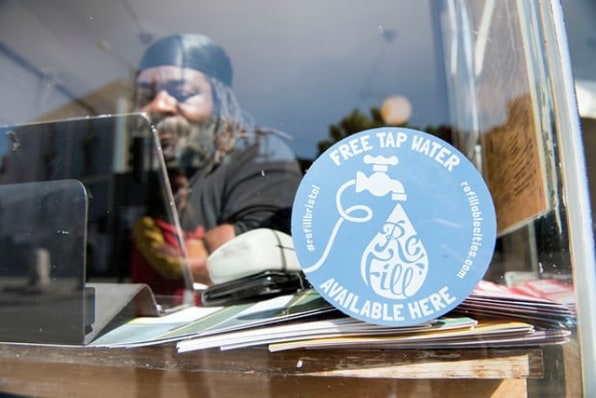Walking past a cafe or bar in London, you might notice a bright blue sticker in the window that says “free tap water.” The message is simple: If you need to refill a reusable bottle, you can come inside.
Part of a grassroots project called the Refill initiative, the stickers were first used in the city of Bristol in 2015. Two months later, 200 businesses had signed up, and the idea quickly spread to other parts of the country and international cities like Hamburg and Berlin. Around 1,600 “refill stations” now exist in the U.K. The stickers will soon become ubiquitous, as a new campaign works with businesses and local agencies to build a network of tens of thousands of refill points in every city and town in England.
It’s not that it wasn’t possible to ask a cafe to refill a bottle in the past–and under the law, all licensed premises in England, including pubs, takeout restaurants, and theaters, are required to provide “free potable water” on request. But most Brits don’t feel comfortable asking. By joining the network, adding a sticker, and becoming part of an app that people can use to find the closest refill location, businesses can help shift norms.

Campaign leaders also want to change perceptions about the convenience of reusable bottles. “It’s communicating the message that you don’t have to carry a heavy water bottle around with you,” says Natalie Fee, the founder of City to Sea, the organization that started the project. “You can leave the house with a small, compact, refillable bottle and just fill it up as you go.”
Water U.K., an organization of water utilities, partnered with the nonprofit to help the campaign quickly scale up. In London, the city government is also planning to encourage businesses to offer refills, and will build 20 new public drinking fountains, with more to potentially follow. Outdoor water sources are also important, Fee says. “Seeing water fountains everywhere and seeing people queue up to use them really makes it normal,” she says. “When people are used to seeing people refilling, that just adds to the culture of reuse.”
Right now, U.K. consumers use 38.5 million plastic bottles every day, and only about half are recycled. The organizers don’t expect to fully replace that use–but if refilling locations are as accessible and visible as convenience stores selling bottled water, habits could easily shift. “We are seeing a really big rise in sales of reusable bottles, so I think that’s indicative of the change,” says Fee.
In the U.S., public refill stations have also become more common over the last several years. In a terminal at San Francisco International Airport, for example, a bottle refill station touts the fact that local tap water comes “direct from California’s Sierra Nevada mountains,” and tells users that they’ve saved energy and emissions, along with waste. A small network of “tap stations” also extends across San Francisco. New York City is installing and repairing 500 water fountain and refill stations. A startup called Reefill is testing a new business model in New York City of a water service that provides free tap water at refill stations, along with chilled, filtered water for members who pay a small fee (to date, it only has eight stations, but plans to add another 100 this year). Cafe “refill points,” however, have grown more slowly in the U.S. TapIt, in the D.C. area, is one example of that type of network. But as Refill grows in the U.K., it may also inspire more action in the United States, where recycling rates are even lower. Fee says that Americans have already started reaching out with an interest in bringing Refill to the U.S., particularly New York and San Diego.
Fast Company , Read Full Story
(35)